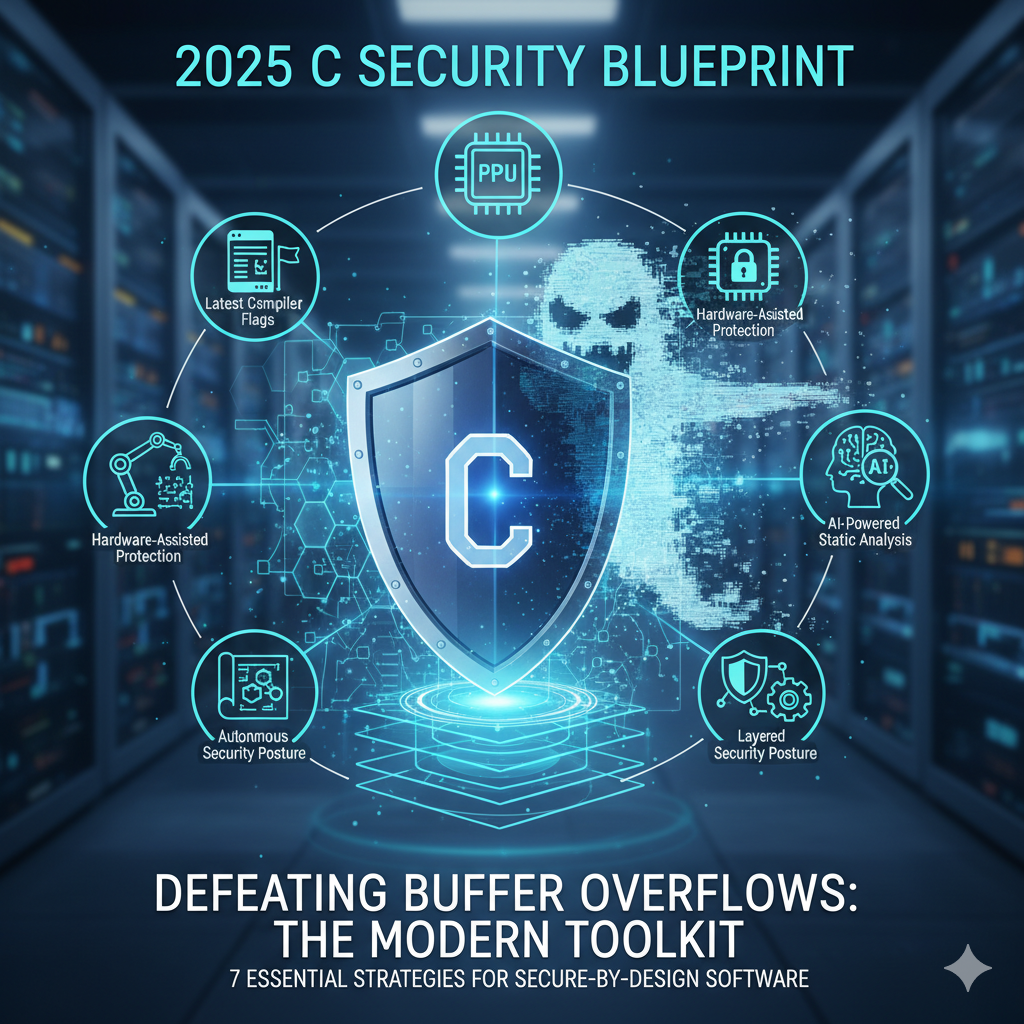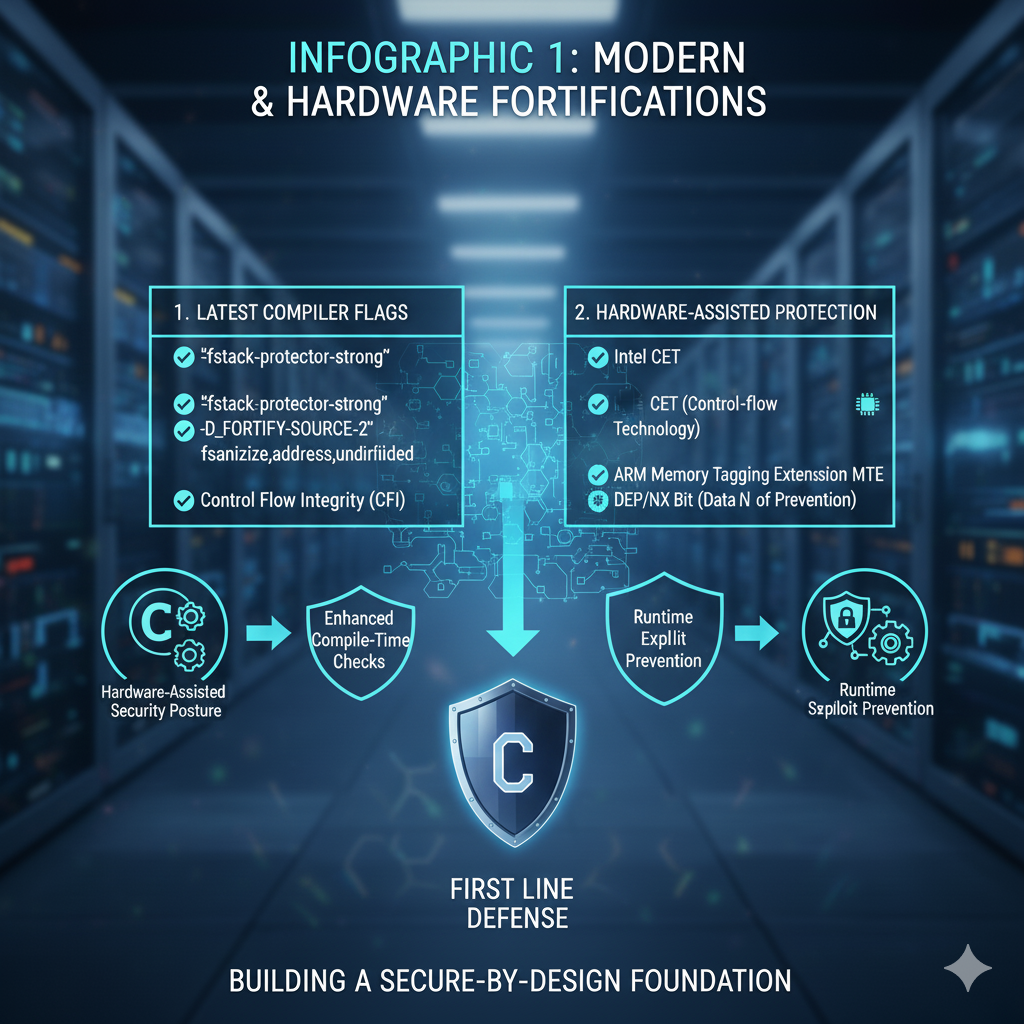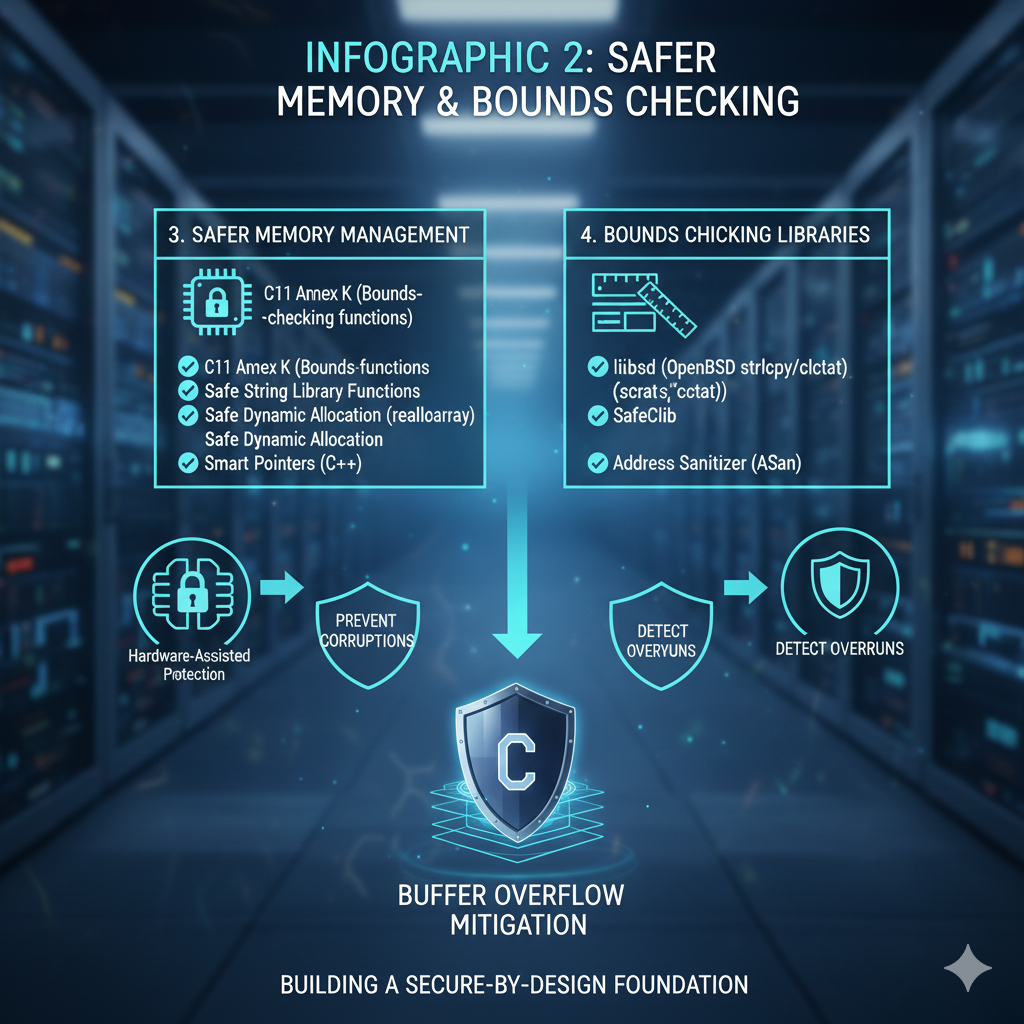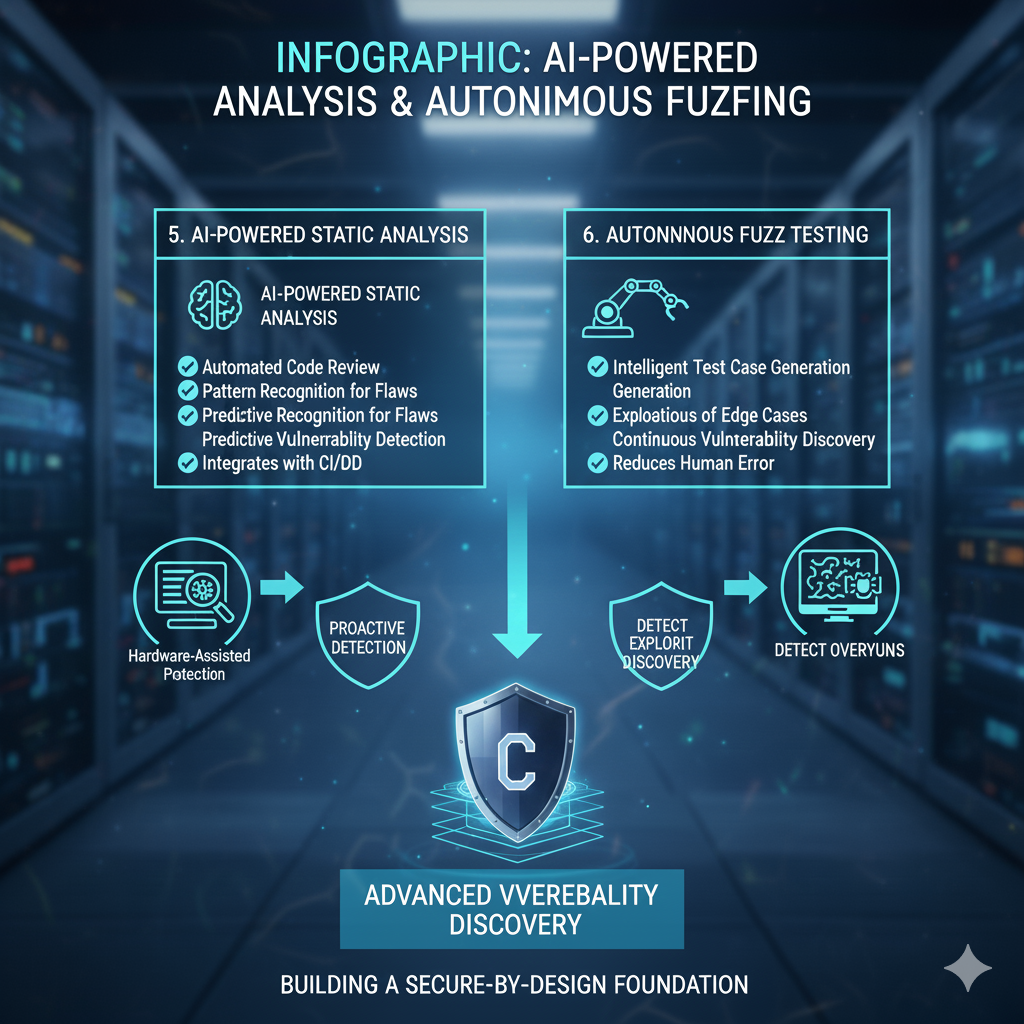
I remember the first time a buffer overflow brought down a piece of my code. It was a simple, embarrassing mistake—a classic strcpy gone wrong—but the feeling of losing control, of watching my program’s execution hijack itself, was a wake-up call.
That was years ago, yet here we are in 2025, and the buffer overflow remains the ghost in the machine, the persistent, dangerous flaw inherent to C’s raw power and manual memory management.
C is the language of performance, the bedrock of nearly everything we use, from operating systems to embedded devices.
But that power comes with a terrifying responsibility. When we manage memory ourselves, we open the door to exploitation.
For decades, we’ve been playing whack-a-mole with this vulnerability. But in 2025, the game has changed. Attackers are smarter, and their tools are automated.
Our defense must be layered, sophisticated, and, yes, even AI-assisted. The days of relying on a single mitigation technique are over.
I’ve compiled the 7 essential mitigation strategies that form the modern C developer’s defense-in-depth toolkit.
This is how we finally defeat the ghost.

Section 1: The First Line of Defense – Code and Compiler
The battle against buffer overflows begins with the code we write and the tools we use to compile it.
This is where we lay the foundation for security.
1. The Safe C Standard: Embracing Bounded Functions
The most common cause of a buffer overflow is a function that doesn’t check the size of the destination buffer.
We all know the culprits: strcpy(), strcat(), gets(), and sprintf(). They are relics of a simpler, less hostile time on the internet.
My personal rule is simple: Treat every input like a ticking time bomb.
The solution is to use bounded, safer alternatives. While the C11 standard introduced functions like gets_s() and others, their adoption is inconsistent.
For maximum portability and security, I rely on these:
- strncpy and strncat: While imperfect (they can leave strings unterminated), they enforce a maximum length.
- snprintf: This is my workhorse. It’s the safest way to format and concatenate strings because it guarantees null termination and respects the buffer size limit.
- Platform-Specific Alternatives: If you are targeting a specific OS, investigate safer, often more intuitive functions like
strlcpyandstrlcat(common in BSD-derived systems), which are designed to be safer drop-in replacements.
The key is to always pass the size of the destination buffer to the function. If the function doesn’t accept a size parameter, you shouldn’t be using it.

2. Compiler-Driven Protection: The Stack Canary
The stack canary is perhaps the most well-known mitigation, and for good reason. It’s the “canary in the coal mine” for your stack.
The Mechanism: The compiler inserts a small, random, secret value (the canary) onto the stack, right before the function’s return address.
If an attacker tries to overflow a local buffer to overwrite the return address, they must overwrite the canary first.
Before the function returns, the program checks if the canary value is still intact.
If it has changed, the program immediately aborts, preventing the attacker from hijacking the execution flow.
In 2025, you should be using the most aggressive compiler flags available:
-fstack-protector-all(GCC/Clang): Don’t just protect functions with large buffers; protect all functions. This is a minimal performance hit for maximum security gain._FORTIFY_SOURCE: This flag, when used with optimization levels (-O1 or higher), tells the compiler to replace vulnerable functions likememcpyandstrcpywith safer, bounds-checking versions where the size of the destination buffer is known at compile time.
3. Input Validation and Sanitization: The Golden Rule
This strategy is about mindset: Never trust user input. This isn’t just about web forms; it’s about network packets, configuration files, environment variables, and command-line arguments.
The Gatekeeper: You must act as the gatekeeper at the castle. Before any data is copied, calculated, or processed, you must perform strict checks:
- Length Check: Is the input size greater than the buffer you are about to copy it into?
- Type Check: Does the input contain only the characters or data types you expect (e.g., only digits for an integer field)?
- Canonicalization: Ensure all data is converted to its simplest, standard form before validation to prevent encoding tricks.
If the input fails any check, discard it, log the error, and handle the failure gracefully—never proceed with potentially malicious data.

Section 2: Operating System and Hardware Fortifications
Once the code leaves your editor, the Operating System steps in to provide a crucial layer of defense. These are system-wide protections that make exploitation exponentially harder.
4. Non-Executable Memory (NX Bit / DEP)
This is the wall we build around the execution zone. The NX (No-eXecute) bit (or DEP – Data Execution Prevention on Windows) marks certain memory pages, like the stack and the heap, as non-executable.
The Impact: The classic buffer overflow attack involves injecting malicious shellcode into a buffer and then redirecting the program’s return address to execute that shellcode.
With NX/DEP enabled, the CPU simply refuses to execute code from a data segment, causing the program to crash instead of running the attacker’s payload.
While nearly ubiquitous today, attackers have found ways around it, primarily through Return-Oriented Programming (ROP), where they chain together small snippets of existing, executable code (called “gadgets”) to achieve their goal. This leads us to the next strategy.
5. Address Space Layout Randomization (ASLR)
If NX is the wall, ASLR is moving the furniture around in the dark.
The Mechanism: ASLR randomizes the base addresses of key memory areas—the stack, the heap, and shared libraries—every time the program runs.
An attacker needs to know the exact memory address of their shellcode or ROP gadgets to succeed. ASLR ensures they are guessing blindly.
The 2025 Context: Early implementations of ASLR (32-bit) could be defeated through brute-force attacks or information leakage vulnerabilities.
Today, 64-bit ASLR is essential, as the massive address space makes brute-forcing practically impossible.
However, developers must still guard against information leakage (e.g., printing a pointer value) which can reveal the randomized base address and defeat ASLR entirely.
Section 3: The Future is Automated – AI and Advanced Testing
This is the frontier of security in 2025. We can no longer rely solely on human review or simple pattern-matching tools.
We must leverage automation and artificial intelligence to find the complex, subtle flaws that lead to modern buffer overflows.
6. AI-Powered Static Analysis Security Testing (SAST)
In the past, SAST tools were notorious for false positives. Today, AI and Large Language Models (LLMs) are revolutionizing this field.
The new generation of AI-powered SAST tools, such as CodeMender, Semgrep, and Corgea, do more than just look for vulnerable function calls. They:
- Understand Data Flow: They trace data from its source (like a network socket) through multiple functions to its sink (like a vulnerable
memcpy), even across complex code paths. - Contextualize Findings: By understanding the intent of the code, AI can drastically reduce false positives, highlighting only the most critical, exploitable flaws.
- Suggest Fixes: Some tools can even auto-generate a secure patch, making the developer’s job faster and more secure.
The Security Co-Pilot: Think of the AI as your tireless security co-pilot, constantly reviewing every line of code you write, catching the subtle off-by-one errors and pointer arithmetic mistakes that a human reviewer would miss at 2 AM.
7. Automated Fuzz Testing and Dynamic Analysis
If static analysis is reading the blueprint, fuzz testing is stress-testing the final building.
The Mechanism: Fuzzers generate massive amounts of malformed, unexpected, and borderline-valid data (the “fuzz”) and feed it to your application to see if it crashes or behaves unexpectedly.
A crash in C often indicates a memory corruption bug, such as a buffer overflow.
The 2025 Standard: Modern fuzzing is no longer random. AI-guided fuzzers (like those used in platforms such as Code Intelligence’s CI Fuzz) use techniques like coverage-guided fuzzing and symbolic execution to:
- Learn the Code: They analyze the application’s structure to understand what kind of input is needed to reach deep, complex code paths.
- Mutate Intelligently: Instead of random noise, they mutate input in ways that are more likely to trigger a bug, focusing on edge cases like maximum buffer limits and boundary conditions.
Integrating AI-guided fuzzing into your Continuous Integration/Continuous Deployment (CI/CD) pipeline is no longer optional—it’s the standard for shipping high-assurance C code.
It’s the relentless, tireless digital attacker you need on your side.
Conclusion: Secure Coding is a Mindset
The C language is not going anywhere. Its speed, efficiency, and proximity to the hardware are irreplaceable. But that means our vigilance against buffer overflows must be equally permanent.
Defeating the buffer overflow in 2025 requires a layered approach:
| Layer | Strategy | Focus |
|---|---|---|
| Code | 1. Safe Functions | Bounded string/memory operations (snprintf). |
| Compiler | 2. Stack Canaries | Aggressive compiler flags (-fstack-protector-all). |
| Input | 3. Validation | Never trust input; strict length and type checks. |
| OS/Hardware | 4. NX/DEP | Prevent execution of data segments. |
| OS/Hardware | 5. ASLR | Randomize memory addresses (64-bit essential). |
| Automation | 6. AI-SAST | Contextual, data-flow-aware vulnerability detection. |
| Testing | 7. AI-Fuzzing | Intelligent, coverage-guided stress testing in CI/CD. |
The responsibility lies squarely with us, the developers.
Secure coding is not a feature you can bolt on at the end; it is a mindset, a commitment to defensive programming at every single layer of your application.
By mastering these 7 strategies, you are not just patching a bug—you are building a secure future for the software that runs the world.
